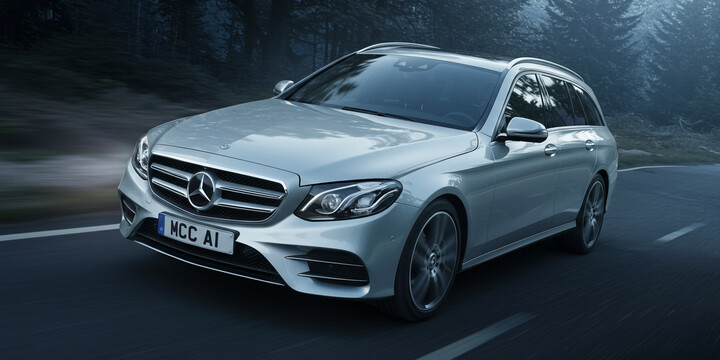
MERCEDES-BENZ E CLASS ESTATE (2016-20)
The **Mercedes-Benz E-Class Estate (2016-20)** is a stylish and practical luxury estate car that's popular among families, professionals, and anyone seeking a blend of comfort, space, and refinement. Positioned in the premium mid-size estate market, it offers ample boot room and versatile seating, making it ideal for both daily commuting and longer family trips. Often chosen for its reputation for smooth driving, high-quality interior finishes, and advanced safety features, the E-Class Estate is a reliable choice for those wanting a classy vehicle that does more than just look good.
What makes the Mercedes-Benz E-Class Estate (2016-20) stand out is its reputation for comfort and durability, with an average mileage around 66,889 miles recorded in recent data, indicating its suitability for years of dependable service. It tends to appeal to those who value a luxurious driving experience combined with practicality. Compared to rivals, it’s renowned for its sophisticated design, advanced technology, and a generally high standard of reliability. Whether you're looking for a prestigious family car or a dependable workhorse, the Mercedes-Benz E-Class Estate (2016-20) remains a compelling choice, blending elegant style with everyday functionality.

average use

The data on the most recent mileage readings for Mercedes-Benz E-Class Estate (2016-20) vehicles indicates that the most common mileage range is between 50,000 and 60,000 miles, accounting for 12.8% of vehicles. There is a notable concentration of vehicles with moderate mileage, particularly in the 80,000 to 90,000 and 70,000 to 80,000 mile ranges, each representing around 7.9% to 10.2%. Conversely, vehicles with very high odometer readings—above 200,000 miles—are quite rare, collectively making up less than 2% of the sample. The distribution suggests that most vehicles tend to be driven within the mid-range mileage, with only a small percentage reaching extreme distances over 300,000 miles.

vehicle values

The data presents private sale price ranges for Mercedes-Benz E-Class Estate (2016-20) vehicles in the UK, along with the percentage of vehicles falling into each range. Notably, the most common private sale prices cluster around the £13,000 to £15,000 mark, comprising approximately 19.3% of the sample (10.2% in £13,000-14,000 and 9.1% in £14,000-15,000). Prices below £10,000 are relatively less frequent, representing a smaller portion of sales, while higher price brackets (above £30,000) have very low percentages, indicating they are less common in private sales. Interestingly, the data shows a broad distribution with relatively modest percentages across most ranges, suggesting a fairly diverse market spread for this vehicle type, with a concentration around the mid-price segment.

production years

The data indicates that among the Mercedes-Benz E-Class Estate models from 2016 to 2020, the majority of vehicles are from 2017, making up approximately 30.9%. Vehicles from 2018 and 2019 are also well represented, constituting around 26.4% and 26% respectively. Notably, only a small fraction of these cars are from 2016 (3%) and 2020 (11.7%). Additionally, a minor presence of vehicles from 2021 (1.9%) suggests some recent registrations or stock turnover. Overall, 2017 appears to be the most prevalent manufacture year within this group.

colour popularity

The data for the main paint colour of 2016-2020 Mercedes-Benz E-Class Estate vehicles shows that black is the most popular choice, accounting for approximately 34.7% of vehicles. This is followed by grey at 24.9%, with blue and white also being common colours at 12.1% and 14% respectively. Silver paint is used in about 9.4% of vehicles, red in 4.2%, and green is the least common, making up only 0.8%. Notably, darker colours like black and grey dominate, reflecting a preference for classic and understated vehicle appearances within this model range.

ownership cycle

The data on registered keepers for the Mercedes-Benz E-Class Estate (2016-20) reveals that a majority of these vehicles have had either 2 or 3 owners, accounting for approximately 60.2% combined. Specifically, 37.4% of the vehicles have had three owners, while 32.8% have had two. A smaller proportion, about 15.8%, have had four owners. The distribution suggests that most of these vehicles tend to change hands a few times rather than being kept by a single owner or passing through many owners. Notably, a small percentage (around 0.8%) have had as many as 8 or 9 owners, indicating a very limited number of vehicles with high ownership turnover. Overall, the data indicates moderate vehicle turnover with a tendency for relatively low numbers of registered keepers per vehicle.

engine choices

The data for the Mercedes-Benz E-Class Estate (2016-20) indicates that the majority of these vehicles are equipped with a 1950cc engine, accounting for 75.5%. The most common engine size overall is 1950cc, with smaller proportions having larger engines, such as 3982cc and 2987cc. In terms of fuel type, diesel vehicles dominate significantly at 81.5%, while petrol models constitute approximately 12.8%. Notably, there are some hybrid and diesel-electric variants, making up around 5.7% combined, indicating a smaller but growing presence of more environmentally friendly options within this model range.












